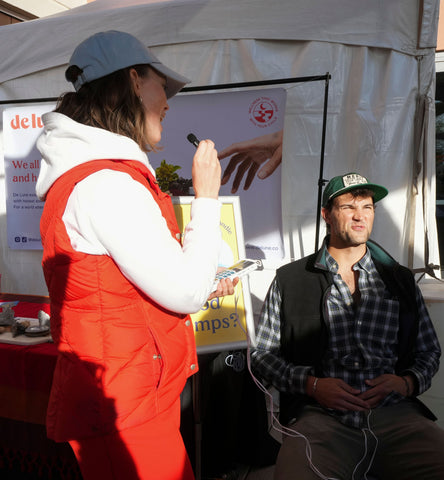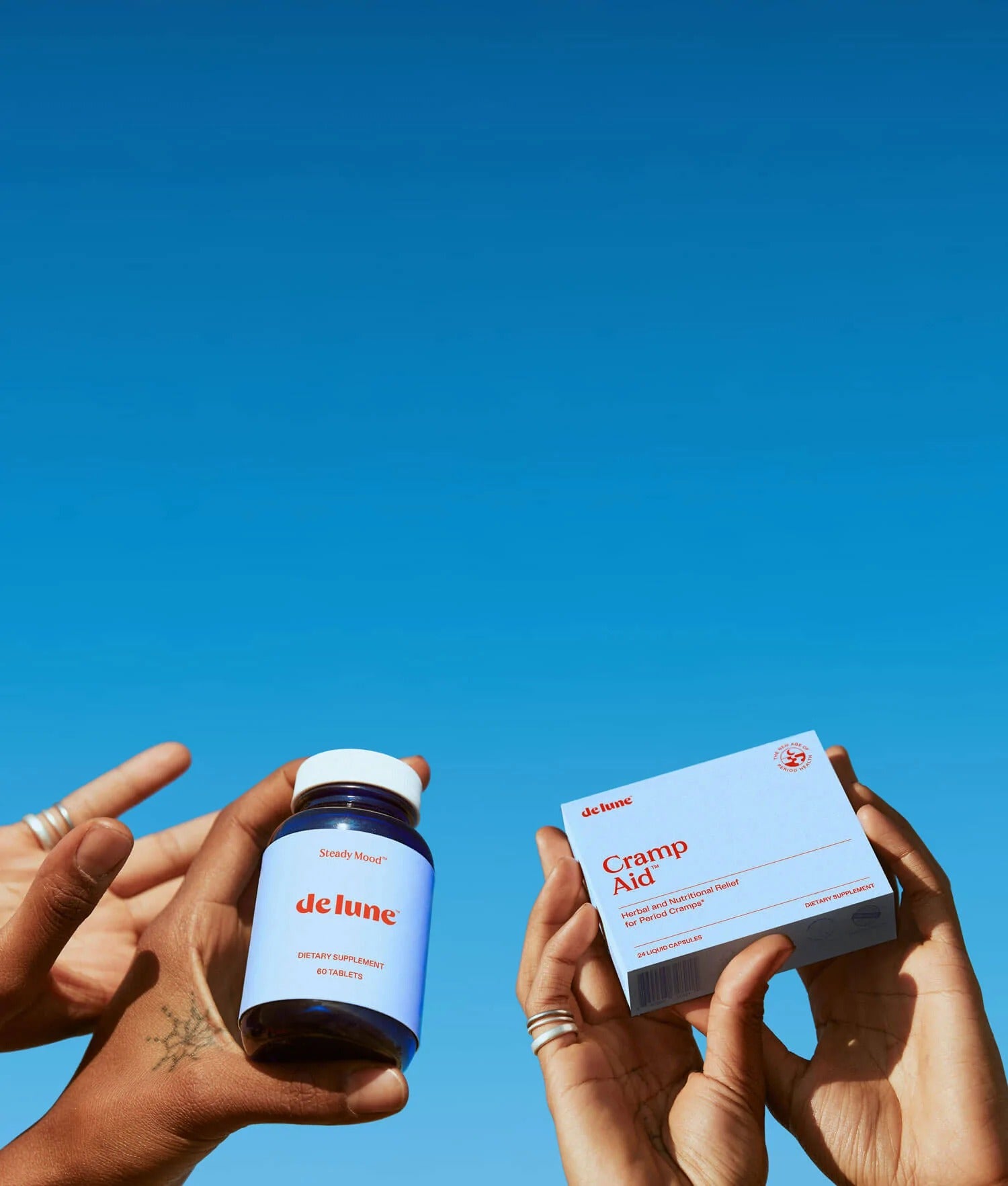If you’re like most people with a period, you take NSAIDs to function during your cycle. Though you may not know what you’re taking are NSAIDs.
‘NSAID’ stands for ‘Non-Steroidal Anti-Inflammatory Drugs’, are they’re a class of over-the-counter painkillers that includes ibuprofen, Advil, aspirin, and Midol.
They’re what most physicians recommend for period pain because they’re relatively cheap, widely available, and work for most people (with some catches you’ll learn about soon).
There’s probably some at the bottom of your bag right now, right next to that emergency tampon and errant hair tie, and you’re ready to pop one (or three) the moment you feel that first cramp coming on.
We know the drill, we’ve been there.
Then we dug into those NSAIDs we were popping every month, and were pretty disgusted by what we found. And in realizing clean living was important to us in all other aspects of our lives, we wondered why we thought it was okay to compromise our wellness values just to survive our periods. (Answer: it’s not okay.)
After searching far and wide for a non-drug solution to period pain, we didn’t find any that actually worked. So we created one. But first, we got really fed up that there wasn’t a good natural alternative to NSAIDs a lot sooner.
So why exactly are NSAIDs not a viable solution to period cramps? Allow us to list the reasons:
1. Risks of side effects with NSAIDs are very real.
They may be a staple in most folks’ medicine cabinets, but that doesn’t make them benign drugs. Their risks of side effects are so serious—sometimes even *gasp* life-threatening—the FDA recently strengthened their warning regarding the heightened risk of heart attack and stroke due to NSAID use.
Common side effects include stomach pain, headache, constipation, diarrhea, gas, heartburn, nausea, vomiting, bloating, dizziness, fatigue, insomnia, and high blood pressure, though more serious side effects have been documented, like gastric ulcers, seizures, blood clots, kidney failure, liver failure, and heart failure.
Serious side effects are rare, but depending on how you react to NSAIDs, they still may cause more problems than they fix.
Like with any drug, the devil’s in the dose, and risks compound with long-term use (like, you know, the cumulative 7ish years you'll spend menstruating throughout your 35-year reproductive life).
The side effects of long-term NSAID use cause nearly 103,000 hospitalizations and 16,500 deaths each year.
We don’t mean to scare you. One study estimates between 11 and 14% of menstruating women taking NSAIDs experience acute side effects (though we’ll note these researchers didn’t measure long-term side effects).1
The way we see it, if NSAIDs can cause organ failure in some people, they’re probably not an ideal go-to solution for anybody.
2. NSAIDs do nothing for long-term menstrual health.
They’re a short-term BandAid to a recurring problem. You get pain, NSAIDs relieve the pain, then your liver metabolizes them out and you’re left with the same amount of pain as you started with. You take more NSAIDs and repeat until your period ends. Ditto for the following month’s cycle, and the cycle after that, etc.
You may be thinking, “Isn’t that how medicine works, though?” Well, yes. But not natural medicine.
In clinical trials that study the effects of vitamins, minerals, and herbs over multiple menstrual cycles, nearly all show period pain further decreased in intensity and duration with each consecutive cycle.3,4,5,6
Meaning natural ingredients aren’t *just* short-term fixes, they also make periods progressively more manageable over time. NSAIDs can’t do that.
It sounds like sorcery, but it’s really science. It also makes sense: natural ingredients nourish, heal, and work with your body, not against.
3. NSAIDs only treat pain.
And anyone who menstruates knows periods are a full mood, brain, and body experience involving a host of unpleasant symptoms, pain among them. Science confirms this: a whopping 150 menstrual symptoms are described in the literature2, the majority of which have nothing to do with pain, but are instead:
- Emotional (e.g. anxiety, depression, mood swings)
- Behavioral (e.g. cravings, insomnia)
- Cognitive (e.g. poor concentration, changes in libido)
- Or physical symptoms unrelated to pain (e.g. fatigue, bloating, nausea, constipation, diarrhea)
So if it’s only cramp relief you’re after, NSAIDs might do the trick (unless you’re 1 in 5 unlucky women, see #5). But if you're PMSing and asking your meds to do more, NSAIDs will come up short every time.
4. NSAIDs were never designed for period pain.
In fact, they weren’t created with women in mind at all. Because of the gender gap in clinical research, the male-dominated medical field deemed women unworthy of studying with any scientific rigor, and believed female hormone fluctuations would pollute data. (FYI - male hormones are also constantly fluctuating 😒)
Most NSAIDs were invented in the 1950s, and women were excluded from clinical trials until 1993. Meaning these drugs were brought to market and widely used for decades without ever being tested on female physiology.
We know, we’re rolling our eyes with you. Which is why we think it’s important that menstrual health solutions are created for women, by women.
5. NSAIDs don’t work for nearly 1 in 5 people with periods.
Like, not at all.7 Scientists aren’t 100% sure why NSAID-resistance is a thing, just that it definitely is. But they suspect genetic changes that impair NSAID absorption or metabolism are likely to blame.8, 9
Anatomical issues may also cause NSAID-resistance, like endometriosis (when uterine cells grow outside the uterus), uterine fibroids (non-cancerous tumors in the uterus) or adenomyosis (when cells that should grow on the lining of the uterus protrude into the wall of the uterus instead).
Either way, if you’re in this camp, you’re not just looking for a natural alternative to NSAIDs for health and safety reasons. You require one to be at your best, all month long.
6. For those who do respond to NSAIDs, research shows natural ingredients are just as effective.
For real. Research on period pain solutions shows:
- Fenugreek is as effective as mefenamic acid (a type of NSAID)10
- Vitamin B1 is as effective as ibuprofen11
- Magnesium is as effective as ibuprofen12
- Ginger is as effective as mefenamic acid and ibuprofen13
(Did we mention you can find all of these in our Pain Tonic? Not a coincidence.)
Importantly, these healing ingredients work their magic (again, it’s science, not actually magic) in a gentle, low-risk way.
In clinical trials that pit NSAIDs against natural ingredients for period pain, nearly all report fewer or zero adverse events in study participants who took the natural stuff. The same cannot be said for those who took NSAIDs.13, 14
Also consider that natural therapies like herbal medicines have been around for thousands of years—eons before big pharma began manufacturing synthetic drugs.
Because natural medicines are time-tested and known to be effective, the active ingredients in many modern pharmaceuticals have an herbal basis. Because they're safe and they work, about 60% of people on this planet rely almost entirely on plants as medication for all health issues,15 including period problems.16
You could be one of those people.
References
1. Marjoribanks, J., Proctor, M., Farquhar, C., Sangkomkamhang, U. S., & Derks, R. S. (2003). Nonsteroidal anti‐inflammatory drugs for primary dysmenorrhoea. Cochrane Database of Systematic Reviews, (4).2.
https://europepmc.org/abstract/med/26224322
2. https://www.sciencedirect.com/topics/medicine-and-dentistry/premenstrual-syndrome
3. Younesy, S., Amiraliakbari, S., Esmaeili, S., Alavimajd, H., & Nouraei, S. (2014). Effects of fenugreek seed on the severity and systemic symptoms of dysmenorrhea. Journal of reproduction & infertility, 15(1), 41.
https://www.ncbi.nlm.nih.gov/pmc/articles/PMC3955423/
4. Azadi, M. M., & Jenabi, E. (2016). Effect of vitamine B1 on the intensity primary dysmenorrheal.
https://www.sid.ir/En/Journal/ViewPaper.aspx?ID=533019
5. Dai, N., Fang, L., Li, Y. B., Wang, Y. M., Yin, J., & Pu, B. C. (2014). Effect of Jingqian Zhitong Fang on serum sex hormone levels in women with primary dysmenorrhea. Evidence-Based Complementary and Alternative Medicine, 2014.
https://www.semanticscholar.org/paper/Effect-of-Jingqian-Zhitong-Fang-on-Serum-Sex-Levels-Dai-Fang/84bc1a3141a5fbb1b91e06fd6df003dad34b843d#extracted
6. Zekavat, O. R., Karimi, M. Y., Amanat, A., & Alipour, F. (2015). A randomised controlled trial of oral zinc sulphate for primary dysmenorrhoea in adolescent females. Australian and New Zealand Journal of Obstetrics and Gynaecology, 55(4), 369-373.
https://obgyn.onlinelibrary.wiley.com/doi/abs/10.1111/ajo.12367
7. Oladosu, F. A., Tu, F. F., & Hellman, K. M. (2018). Nonsteroidal antiinflammatory drug resistance in dysmenorrhea: epidemiology, causes, and treatment. American journal of obstetrics and gynecology, 218(4), 390-400.
https://www.sciencedirect.com/science/article/pii/S0002937817310955
8. Ulehlova, J., Slavik, L., Kucerova, J., Krcova, V., Vaclavik, J., & Indrak, K. (2014). Genetic polymorphisms of platelet receptors in patients with acute myocardial infarction and resistance to antiplatelet therapy. Genetic testing and molecular biomarkers, 18(9), 599-604.
https://www.ncbi.nlm.nih.gov/pmc/articles/PMC4150366/
9. Weng, Z., Li, X., Li, Y., Lin, J., Peng, F., & Niu, W. (2013). The association of four common polymorphisms from four candidate genes (COX-1, COX-2, ITGA2B, ITGA2) with aspirin insensitivity: a meta-analysis. PloS one, 8(11), e78093.
https://journals.plos.org/plosone/article?id=10.1371/journal.pone.0078093
10. Inanmdar, W., Sultana, A., Mubeen, U., & Rahman, K. (2016). Clinical efficacy of Trigonella foenum graecum (Fenugreek) and dry cupping therapy on intensity of pain in patients with primary dysmenorrhea. Chinese journal of integrative medicine, 1-8.
https://link.springer.com/article/10.1007/s11655-016-2259-x
11. Zafari, M., Aghamohammady, A., & Tofighi, M. (2011). Comparing the effect of vitamin B1 (vit. B1) and ibuberofen on the treatment of primary dysmenorrhea. Afr. J. Pharm. Pharmacol, 5(7), 874-878.
http://www.academicjournals.org/app/webroot/article/article1380796129_Zafari.pdf
12. Julie, G. (2013). Comparison between Magnesium Supplement and Ibuprofen as Treatments of Primary Dysmenorrhea and Dietary Intake of School Going Girls in Machakos, Kenya: Randomized Trial (Doctoral dissertation, Kenyatta University).
https://ir-library.ku.ac.ke/bitstream/handle/123456789/9035/Gogi,%20Julie%20.pdf?sequence=1
13. Ozgoli, G., Goli, M., & Moattar, F. (2009). Comparison of effects of ginger, mefenamic acid, and ibuprofen on pain in women with primary dysmenorrhea. The journal of alternative and complementary medicine, 15(2), 129-132.
http://jupiterpharma.in/journalpdf/ginger%20in%20Primary%20Dysmennorhoea.pdf
14. Shirvani, M. A., Motahari-Tabari, N., & Alipour, A. (2015). The effect of mefenamic acid and ginger on pain relief in primary dysmenorrhea: a randomized clinical trial. Archives of gynecology and obstetrics, 291(6), 1277-1281.
https://www.researchgate.net/profile/Abbas_Alipour/publication/268389549_The_effect_of_mefenamic_acid_and_ginger_on_pain_relief_in_primary_dysmenorrhea_A_randomized_clinical_trial/links/546b28120cf2f5eb18088ae7/The-effect-of-mefenamic-acid-and-ginger-on-pain-relief-in-primary-dysmenorrhea-A-randomized-clinical-trial.pdf
15. Al-dalain, S., El-kutry, M. S., & Ibrahim, H. S. (2008). Inhibitory effect of aqueous extracts of barley and fenugreek on ulcer induction in rats. World Appl Sci J, 5(3), 332-9.
https://pdfs.semanticscholar.org/83c3/b8e496b490809a482e424b4aa9634e97fd27.pdf
16. Yassin, S. A. (2012). Herbal remedy used by rural adolescent girls with menstrual disorders. J Am Sci, 8(1), 467-73.
http://www.jofamericanscience.org/journals/am-sci/am0801/065_7998am0801_467_473.pdf







